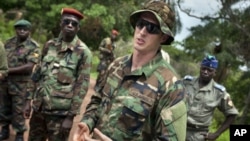For years, Joseph Kony and his Lord's Resistance Army, or LRA, have terrorized the people of central Africa, abducting thousands of children and killing hundreds of people in a brutal insurgency. Many people hope the arrival of U.S. special forces in the region will bring an end to the group.
At Radio Zereda in Obo, Central African Republic, an announcer broadcasts a special program for LRA victims.
He tells those who have been kidnapped by the rebel group to escape and go back to their homes, where their families will accept them no matter what atrocities they might have committed.
Emmanuel Daba, one of the broadcasters at Radio Zereda and the head of an LRA victim's association was abducted by in 2008, and spent a year with the rebels. "We conducted raids on villages in South Sudan and the Congo," he says. "We killed a lot of people with machetes, with sticks and clubs," he said.
Daba was one of thousands of boys and girls abducted by the LRA since the group launched an insurgency in Uganda more than 20 years ago.
Since then, the group has expanded into South Sudan, the Democratic Republic of Congo and the Central African Republic. Once numbering in the thousands, the LRA now is believed to have only a few hundred fighters at the most.
People here in Obo are optimistic that the recent arrival of U.S. special forces will help deliver the final blow to the elusive group.
Inside the Counter-LRA Operations Fusion Center in the Central African Republic, U.S. advisors meet with their counterparts from the Ugandan military and the Central African Armed Forces.
Maps of Central Africa line the walls in the main conference room, along with photographs of LRA commanders, including the group's leader Joseph Kony.
The center is part of the U.S. advise and assist mission in central Africa, a deployment authorized by President Barack Obama last year.
U.S. commanders say the troops are not going out on patrols, but are working in the background, to improve the capacity of regional militaries.
“Information in this theater is critical, said Navy Captain Ken Wright, the Commander of U.S. Counter-LRA activities. “And so our ability to push large amounts of information around the area is where we provide a lot of 'gap fillers,' if you will, where our partner nations do not have those capabilities. And we see those as the strong points where we bring things to the table that a couple more people on a patrol would just not provide as much affect.”
Ugandan military spokesman Army Colonel Felix Kulayigye says U.S. intelligence support could be the turning point in the hunt for Kony. “As you are aware, a military without intelligence is as good as a blind person. We believe this support will definitely help us capture Kony or kill him," he said.
Despite advanced intelligence, finding Kony is no easy task. His rebels have all but abandoned using mobile or satellite telephones to communicate with one another, making them very difficult to track.
Colonel Kulayigye says intelligence reports suggest that Kony is somewhere in the Central African Republic, although he recently said the rebel leader was in the southern Darfur region of Sudan.
The United Nations reports there have 53 LRA attacks in the Democratic Republic of Congo and the Central African Republic during the first three months of the year.
And although LRA attacks have be less frequent and less deadly than in recent years, fear of the group continues to keep people awake at night in the villages of central Africa.
News
US Uses Advanced Intelligence in Fight Against LRA in Central Africa
- By Gabe Joselow








